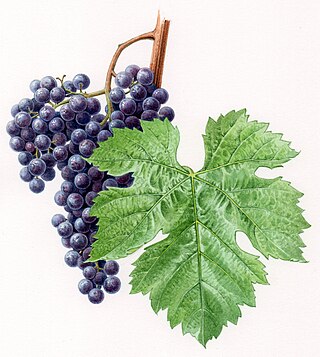
Merlot is a dark blue–colored wine grape variety that is used as both a blending grape and for varietal wines. The name Merlot is thought to be a diminutive of merle, the French name for the blackbird, probably a reference to the color of the grape. Its softness and "fleshiness," combined with its earlier ripening, make Merlot a popular grape for blending with the sterner, later-ripening Cabernet Sauvignon, which tends to be higher in tannin.

Cabernet Sauvignon is one of the world's most widely recognized red wine grape varieties. It is grown in nearly every major wine producing country among a diverse spectrum of climates from Australia and British Columbia, Canada to Lebanon's Beqaa Valley. Cabernet Sauvignon became internationally recognized through its prominence in Bordeaux wines, where it is often blended with Merlot and Cabernet Franc. From France and Spain, the grape spread across Europe and to the New World where it found new homes in places like California's Napa Valley, New Zealand's Hawke's Bay, South Africa's Stellenbosch region, Australia's Margaret River, McLaren Vale and Coonawarra regions, and Chile's Maipo Valley and Colchagua. For most of the 20th century, it was the world's most widely planted premium red-wine grape until it was surpassed by Merlot in the 1990s. However, by 2015, Cabernet Sauvignon had once again become the most widely planted wine grape, with a total of 341,000 hectares (3,410 km2) under vine worldwide.

Malbec is a purple grape variety used in making red wine. The grapes tend to have an inky dark color and robust tannins, and are known as one of the six grapes allowed in the blend of red Bordeaux wine. In France, plantations of Malbec are now found primarily in Cahors in South West France, though the grape is grown worldwide. It is also available as an Argentine varietal.

Chile has a long history in the production of wine, with roots dating back to the 16th century when the Spanish conquistadors introduced Vitis vinifera vines to the region. In the mid-19th century, French wine varieties such as Cabernet Sauvignon, Merlot, Carmenère, and Cabernet Franc were introduced. During the early 1980s, the Chilean wine industry underwent a renaissance with the introduction of stainless steel fermentation tanks and the use of oak barrels for aging. This led to a rapid growth in exports as quality wine production increased. The number of wineries in Chile rose from 12 in 1995 to over 70 in 2005.
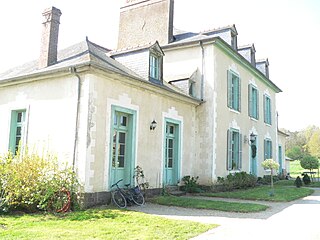
Pomerol is a commune in the Gironde department in Nouvelle-Aquitaine near Bordeaux in southwestern France.
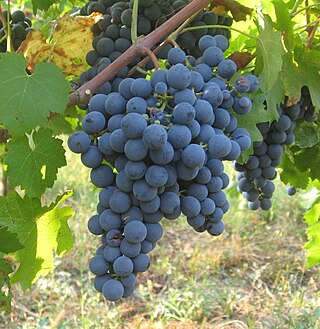
The Carménère grape is a wine grape variety originally planted in the Médoc region of Bordeaux, France, where it was used to produce deep red wines and occasionally used for blending purposes in the same manner as Petit Verdot.
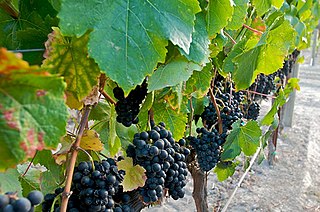
Petit Verdot is a variety of red wine grape, principally used in classic Bordeaux blends. It ripens much later than the other varieties in Bordeaux, often too late, so it fell out of favour in its home region. When it does ripen it adds tannin, colour and flavour, in small amounts, to the blend. Petit verdot has attracted attention among winemakers in the New World, where it ripens more reliably and has been made into single varietal wine. It is also useful in 'stiffening' the mid palate of Cabernet Sauvignon blends.

Bordeaux wine is produced in the Bordeaux region of southwest France, around the city of Bordeaux, on the Garonne River. To the north of the city, the Dordogne River joins the Garonne forming the broad estuary called the Gironde; the Gironde department, with a total vineyard area of 110,800 hectares, is the second largest wine-growing area in France behind the Languedoc-Rousillon.

Tannat is a red wine grape, historically grown in South West France in the Madiran AOC, and is now one of the most prominent grapes in Uruguay, where it is considered the "national grape".
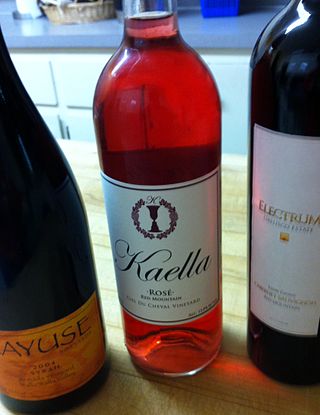
Washington wine is a wine produced from grape varieties grown in the U.S. state of Washington. Washington ranks second in the United States in the production of wine. By 2017, the state had over 55,000 acres (220 km2) of vineyards, a harvest of 229,000 short tons (208,000 t) of grapes, and exports going to over 40 countries around the world from the 940+ wineries located in the state. While there are some viticultural activities in the cooler, wetter western half of the state, the majority (99.9%) of wine grape production takes place in the shrub-steppe eastern half. The rain shadow of the Cascade Range leaves the Columbia River Basin with around 8 inches (200 mm) of annual rain fall, making irrigation and water rights of paramount interest to the Washington wine industry. Viticulture in the state is also influenced by long sunlight hours and consistent temperatures.

The wine regions of Bordeaux in France are a large number of wine growing areas, differing widely in size and sometimes overlapping, which lie within the overarching wine region of Bordeaux, centred on the city of Bordeaux and covering the whole area of the Gironde department of Aquitaine.

Marselan is a red French wine grape variety that is a cross between Cabernet Sauvignon and Grenache. It was first bred in 1961 by Paul Truel near the French town of Marseillan. The vine is grown mostly in the Languedoc wine region with some plantings in the Northern Coast of California. It has also become very popular in China. The grape usually produces a medium body red wine.

In the Bordeaux wine region there are seven regional Appellations d'origine contrôlée (AOCs) that may be used throughout the Gironde department. These are Bordeaux Rouge AOC, Bordeaux Supérieur Rouge, Bordeaux Clairet, Bordeaux Rosé, Bordeaux Blanc, a dry white, Bordeaux Supérieur Blanc, a sweet white, and Crémant de Bordeaux, a sparkling méthode traditionnelle wine. The regional appellations together form the largest world-class wine vineyard, making up more than half of the production of the prestigious Bordeaux wine region, and representing more than 55% of all Bordeaux wines consumed in the world.

Friuli-Venezia Giulia wine is wine made in the northeastern Italian region of Friuli-Venezia Giulia. There are 11 denominazione di origine controllata (DOC) and 3 denominazione di origine controllata e garantita (DOCG) in the Friuli-Venezia Giulia area. The region has 3 indicazione geografica tipica (IGT) designations Alto Livenza, delle Venezie and Venezia Giulia. Nearly 62% of the wine produced in the region falls under a DOC designation. The area is known predominantly for its white wines, which are considered some of the best examples of Italian wine in that style. Along with the Veneto and Trentino-Alto Adige, the Friuli-Venezia Giulia forms the Tre Venezie wine region, which ranks with Tuscany and Piedmont as Italy's world class wine regions.

Ornellaia is an Italian wine producer in the DOC Bolgheri in Toscana, known as a producer of Super Tuscan wine. Ornellaia is considered one of Italy's leading Bordeaux-style red wines. The estate also produces a second wine, Le Serre Nuove, the blend Le Volte, the Merlot-labeled varietal wine Masseto, in addition to estate production of grappa and olive oil. In 2012, the winery's name was changed from "Tenuta dell'Ornellaia" to "Ornellaia e Masseto", in recognition of the increasing importance of the Merlot-based wine.

Pomerol is a French wine-growing commune and Appellation d'origine contrôlée (AOC) within the Libournais in Bordeaux. The wine produced here is predominately from Merlot with Cabernet Franc playing a supporting role. Unlike most other Bordeaux communes, there is no real village of Pomerol, although there is a church. The houses are set among the vineyards.

Champoux Vineyard is a grape growing estate located in the Horse Heaven Hills AVA of Washington state. Grapes grown in the vineyard have been used to produce some of the most critically acclaimed Washington wines with the name Champoux regularly being featured on vineyard designated wines. Paul Gregutt, wine writer for the Seattle Times and Wine Enthusiast, list Champoux as one of the "top ten" vineyards in the entire state. Cabernet Sauvignon grapes from Champoux vineyards were featured in the consecutive 100 point Robert Parker rated wines from Quilceda Creek Vintners for the 2002 and 2003 vintages.

Puisseguin-Saint-Émilion is an Appellation d'origine contrôlée (AOC) for wine in the Bordeaux wine region of France, where it is situated in the Libourne subregion on the right bank of the Dordogne. It was granted AOC status on 14 November 1936, and the AOC designation granted to the wines which have been harvested on the land of the Puisseguin commune. 753 hectares of vine planted areas have belonged to the appellation in 2005, with a production of 34,648 hl.

Blackbird Vineyards is a Napa Valley based winery. It is part of the Bespoke Collection. Founder Michael Polenske wanted to create a winery that focused on producing wines from Merlot grapes, which fits with the name "Blackbird", as merlot means "young blackbird", in French patois. Blackbird Vineyards creates wines inspired by the Pomerol area of France. The winery calls their wines "California Bordeaux".

Force Majeure is a Washington/Oregon wine estate, specializing in Syrah, Cabernet Sauvignon as well as other Bordeaux and Rhone-inspired blends. The brand was founded in 2004, and beginning with that vintage began the "Collaboration Series" of wines made by some of Washington's top winemakers, using fruit from Red Mountain's Ciel du Cheval vineyard. Since 2014, the wines have been made by acclaimed winemaker Todd Alexander, who moved from the Napa Valley to the Pacific Northwest at that time. The brand labels also changed in 2014, to signify the winemaking change and the use of their estate vineyards for the wines, going forward. Todd Alexander continues to craft these limited production wines to this day.

























